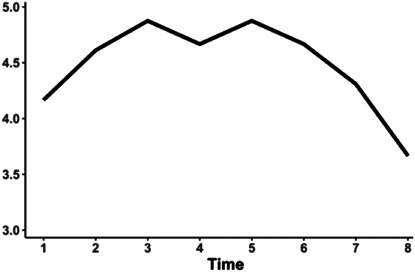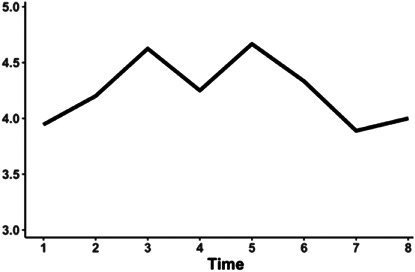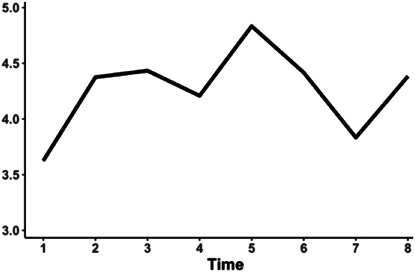TABLE 4.
Implementation Climate, by Clinic
| Trajectories | PHC Staff Experiences | Illustrative Quotes | |
| Clinic A |
 Intercept: 4.24* Time: 0.38* Time2: −0.06 |
PHC research staff felt supported by and had strong communication with clinic staff. Clinic leadership was highly engaged throughout and regularly sent email updates to clinic staff and discussed PHC during meetings. Early on and toward the end of the study, some clinical staff got upset when PHC caused delays in the clinic workflow. No clear theme emerged explaining a decline in climate at the end. |
“Oh yeah. We definitely are all updates are sent to us during staff meetings in the clinic. We are kept in the loop.” (T3, Project Coordinator) “Well, anytime you make a change to something, folks who are established in a particular clinic can feel like this is one more thing we got to do and we try not to make that a burden for them but for us to handle it.” (T5, Project Coordinator) |
| Clinic B |
 Intercept: 3.92* Time: 0.38* Time2: −0.06* |
PHC was supported by the clinic and staff expectations were consistently communicated. The most common leadership method used to support PHC was advocating for the study in clinical site staff meetings. There were changes at T4, including hiring a new clinical champion and data manager and moving to a new building, which temporarily decreased champion engagement. Toward the end, troubleshooting and problem solving was expected to be done independently by the research team with only ad hoc support from the clinical champion. |
“I think it's been pretty unique at this clinic because we had so many changes in the past 3 months with […], our previous PI leaving and […], our data person, being absent for a while and the clinic moving, that it’s definitely leadership has been a little bit more absent than I think we'd like.” (T4, Outreach Coordinator) “On our monthly clinician meetings or provider meetings we always do some sort of update or reminder to the folks that, whether they're working on re-engagement or recruiting, we let the providers know, you know, that it’s happening.” (T6, Clinical Champion) |
| Clinic C |
 Intercept: 4.11* Time: 0.42* Time2: −0.05* |
There was a lot of support within the clinic for PHC. The clinic had 2 clinical champions but not until T2 did PHC staff note feeling supported. Leadership engagement and support were mainly provided through routine or ad hoc meetings. Clinical staff showed their support by being flexible in their schedules and helping to identify patients. |
“Leadership is very involved and that I can call either one of the PIs on this study and ask them a question right now and they would help me. And if they couldn't help me they would find a way to help me. (…) They're always really available for us.” (T2, Data Manager) “We support each other […] we always talk to each other, the case managers, the outreach people, the social worker, nutritionist. All is integrated here in the clinic, and mostly we work together.” (T7, Project Coordinator) |
| Clinic D |
 Intercept: 4.13* Time: 0.38* Time2: −0.05* |
The research team felt supported by clinic leadership. Although some were more involved than others, the clinical champion was engaged throughout. Early on, and at T6 and T7, staff noted a disconnect between PHC staff and clinic staff because of poor communication and resistance from clinical staff to adjust the clinic's workflow to support the project. Implementation climate improved when the clinical champion helped troubleshoot problems for PHC staff. |
“We were still figuring out who should be doing what and at what time or at what stage of the patients' visit. But I think now everything is working pretty well and everyone more or less knows what they need to be doing.” (T2, Project Coordinator) “Yeah, I help to troubleshoot all the problems in terms of implementation, recruitment, I work closely with my team to do that.” (T5, Clinical Champion) |
Time refers to measurement time point, T1 to T8. The Time variable indicates how fast the outcome is increasing over time. The Time2 variable indicates how fast the outcome starts moving back to values from earlier in the study. The combination of these two effects describes the upside-down “u” shape of the trajectory over time.
P < 0.05 indicates a significant change over time.
